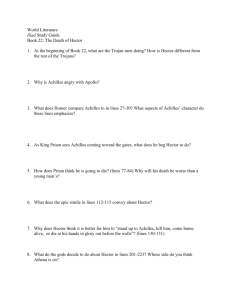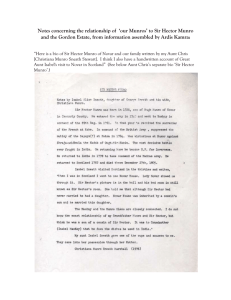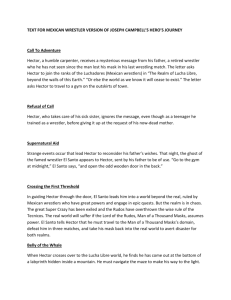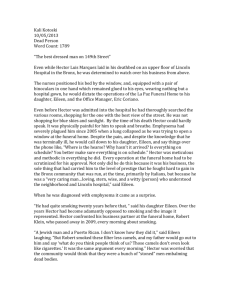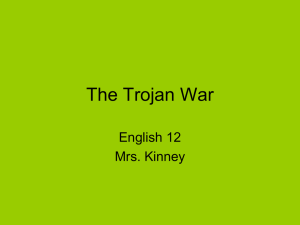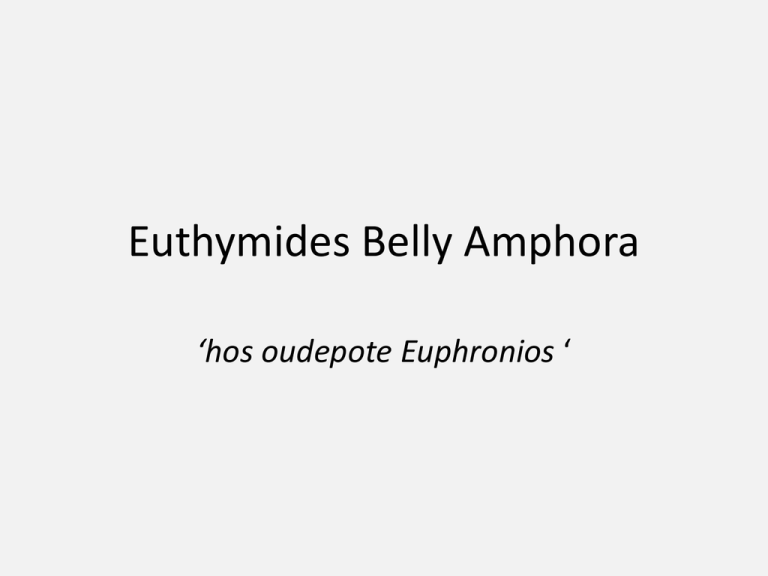
Euthymides Belly Amphora
‘hos oudepote Euphronios ‘
overview
•
•
•
•
•
•
•
510 – 500 BC
Painter: Euthymides Potter: Unknown
Red Figure
Belly Amphora
Height – 60 cm
Pioneer group
Inscription telling us it’s his!
SIDE A
SIDE B
The shape
• This vase is an belly amphora
• It was supposedly invented by
the potter Exekias or maybe the
Myceneans (debated)
• In proto-geometric period
• Liquids: oil, wine, and honey
• Large neck, belly almost as wide
as it is tall, continious line from
mouth to foot & flat handles
Side A
This side is often referred to
as the three revelers.
Shows three men returning
from a symposium after a
night of drinking
Komachos, Euedemos & Teles
Mood of frienze: Happy
Characters & Drinking
• Komachos is holding a Kanthraros or a
drinking cup which shows that he has been
drinking
• There are vine leaves around all of the mens
heads – which represent alcohol (only really
wine at that time)
• With the use of poses – Euthymides has
captured the characters in a drunken dance
• Eroticism – penis’ are visible and the eyes of Teles
and Euedemos are on the others mens junk.
• Also the scene depicts Teles reaching for
Euedemos’ junk (with his hand), Euedemos
reaching down for Komachos’ while Komachos
seems to be trying to protect himself from the
wandering hands of Teles and Euedemos.
Painting technique
• Red figure: was able to give more of an illusion
of volume and depth compared to the flat
black silhouette
• Detail: painted not incised. Continuous fluid
lines, better able to give impression of volume
• Purple slip
• Dark & Dilute glaze
are used to highlight
major & minor
muscles
Boarders: all around
Top: enclosed red figure
palmettes
Sides: black figure
linked to pomegranates
Bottom: stylized black
figure buds
Black band: there are
large bands above and
below the scene, as an
additional frame
Ray bands
Composition
Handles: flanged handles
are decorated with ivy
leaves
Walking stick: there is a
slight interruption to
the boarder
Shoulders: shoulder
contours of figures
follow shoulder
contours of vase
Depth: there is no
overlapping of the
figures to suggest depth
Ground line: simple ground
line suggest no depth
Komachos: stands in
profile. His torso is at
a ¾ angle
Painting style
Euedemos:
Unusual pose. Legs
are profile, ¾
buttocks, full back
view, face in
profile. Not a
stationary positiion
Anatomy: interest
apparent in this
scene. Studied live
models and real
world. New trend,
poses are realistic
Mood: clearly
drunken revelry.
Shown by high
stepping. The
drapery flows away
from bodies to
accentuate
movement
Lack of Background:
just glossy glaze
Drapery: purely
decorative. Hangs in
the same zigzag
folds
Teles: Top is in
profile while bottom
is frontal
Poses: complex
Lack of Depth: No overlapping. It’s no
exploited in order to give depth to the
scene
Naturalism: continuing
interest in naturalism.
Realistically moulded
muscles.
Foreshortening:
the feet and back
of Euedemos
Side B
Story of King Priam, Prince
Hector, and Queen Hecuba
Scene taken from Trojan war
Depicts the arming of Hector
before his fight with Achilles, it is
the final goodbye of parents and
child, as Hector will die in this
fight : (
Myth
Hector, son of King Priam of Troy, was the greatest
of the Trojan warriors. He led the Trojans in the
Trojan War, since Priam was too old to fight.
Hector killed Patroclus, and Achilles met Hector in
a crucial scene in “The Iliad”. Achilles killed
Hector before dragging his body from the back of
his chariot around Patroclus’ tomb, every day for
12 days. With Hector’s death, the fall of Troy was
close at hand.
Context
Cloaks: there are stiff
folds in the cloak
around King Priam’s
back
Loose chiton: zigzag
bottom to the material
Hector strains as he
puts on his armour
showing the somber
moment
Pose: Hector looks
quite awkward –
painted with frontal
body but head and
right leg are in
profile
Poses: Hector’s pose
still looks unrealistic
and awkward, but
Euthymides is
experimenting with
foreshortening, and
mixing frontal with
profile figures.
Inscription: between Priam
& Hector: ‘Euthymides the
son of Polias painted (me)’
Foreshortening: Hectors foot
Mood: Somber. King
Priam watches and
gives his son some
advice (as shown
through the
movement of this
fingers)
Palmette
This palmette decorative band runs around the top
of the frieze, but is interrupted by Hector’s raised
helmet. This shows Euthymides’ skill in
composition.
KING PRIAM
characters
Aged father,
bald head,
stubbly beard.
QUEEN HECUBA
Dressed in a long
chiton, and
himation
Priam’s cloak is stiff and unrealistic vs. Queen
Hecuba’s lose, flowing folds in her chiton
Wrapped up
tightly in his
cloak.
Right hand
gesticulates to his
son as if offering
advice
He holds a
knobbed stick in
his left hand
She holds Hector’s
spear and is
offering her son his
helmet
His helmet his
leaning against his
mother
Helmet: interesting
move – the raised
helmet disrupts the
upper band of
decoration
Hector the protector,
Hero of Troy
Hector & Gear
Greatest of all Trojan
warriors in Homer’s Iliad.
He killed many Greeks
until finally being killed
by Achilles
In process of
putting on his
leather corselet.
Assisted by parents
Straining to put on
corselet – shows somber
moment
Hero Shield: head of a satyr
Comparative composition
Both sides of the vase show 3 figures, a
composition typical for Euthymides.
This provides a balance on both friezes, but
also allows him to contrast different poses on
either side.
Realism
This is a Red-Figure vase, so details are painted
on, not incised. This allows the artist to show
more complex poses and a more realistic
scene is possible.
Euthymides uses dilute slip to show the
muscle groups. He even uses dark slip for
major muscles, and lighter slip for small ones.
The accuracy shown here suggests he actually
observed live models. This was new!
Limitations
• No overlapping
• There is no attempt at background, just black
glaze.
• The figures stand on a single groundline,
giving no depth.
• Red figure is far more capable of giving an
illusion of volume and depth than the flat
silhouette of black figure, yet Euthymides
does not exploit this.


